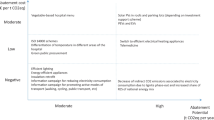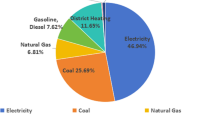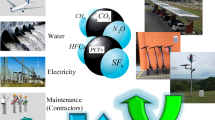Abstract
It is a scientifically accepted fact that climate change constitutes a major challenge for the future well-being of the whole humanity. Medical and hospital care facilities generate their own greenhouse emissions. Hospital transportation activities encompass not only the transportation of patients and medical personnel but also the operation of transportation assets associated with the logistical support of hospital operations. The present research focuses on the carbon footprint of the transportation functions and activities of the 401 Military General Hospital of Athens (401 MGHA), in order to serve as a starting point for the development of an action plan for the mitigation of greenhouse gas emissions in the hospital-based healthcare of the Hellenic (Greek) Army. Based on this, a simple and easily operated monitoring scheme of the greenhouse gas emissions of the transport activities and a portfolio of mitigation actions are proposed. The estimation of the carbon footprint of the transport activities, and of the other stationary emission sources of the hospital (energy consumption, waste treatment, etc.) of the 401 MGHA, will be the starting point for the development of an action plan for the estimation and mitigation of GHG emissions in the hospital-based healthcare of Greece.
Similar content being viewed by others
References
World Health Organization and Health Care Without Harm (2009). Healthy Hospitals – Healthy Planet – Healthy People. Addressing climate change in health care settings. Discussion draft paper [online]. http://www.who.int/globalchange/publications/healthcare_settings/en/ (Accessed 6 August 2019).
Pachauri, R. K., & Meyer, L. A. (Eds.). (2014). Climate change 2014: Synthesis report. Contribution of working groups I, II and III to the Fifth Assessment Report of the Intergovernmental Panel on Climate Change. Geneva: IPCC.
Schneider, S. H. (1997). Integrated assessment modeling of global climate change: Transparent rational tool for policy making or opaque screen hiding value-laden assumptions. Environmental Modeling and Assessment, 2(4), 229–249.
Sebos, I., et al. (2016). Mitigation and adaptation policies related to climate change in Greece. In P. Grammelis (Ed.), Energy, Transportation and Global Warming. Green Energy and Technology (pp. 35–49). Cham: Springer.
Careri, F., et al. (2012). Impact of GHG emission reduction on power generation expansion planning. In Q. P. Zheng, S. Rebennack, P. Pardalos, M. V. F. Pereira, & N. A. Iliadis (Eds.), Handbook of CO2 in power systems (pp. 205–242). Springer.
NOAA's National Centers for Environmental Information (2019). Global Climate report 2019 [online] https://www.ncei.noaa.gov/news/global-climate-201912 (Accessed 1February 2020).
Holmner, A., Ebi, K. L., Lazuardi, L., & Nilsson, M. (2014). Carbon footprint of telemedicine solutions - unexplored opportunity for reducing carbon emissions in the health sector. PLoS One, 9(9). https://doi.org/10.1371/journal.pone.0105040.
Eckelman, M., & Sherman, J. (2016). Environmental impacts of the U.S. health care system and effects on public health. PLoS ONE, 11(6). https://doi.org/10.1371/journal.pone.0157014.
Margaritis, N., Dallas, P., Grammelis, P., & Giannakopoulos, P. (2016). Implementation of a sustainable energy action plan for municipality of Ptolemaida. International Journal of Global Warming, 10(1–3), 55–74.
Schade, B., Wiesenthal, T., Gay, S. H., & Leduc, G. (2011). Potential of biofuels to reduce greenhouse gas emissions of the European transport sector. In W. Rothengatter, Y. Hayashi, & W. Schade (Eds.), Transport moving to climate intelligence. Transportation research, economics and policy (pp. 243–269). New York: Springer.
Eva Krtkova, E., Fott, P., & Neuzil, V. (2014). Carbon dioxide emissions from natural gas combustion – Country-specific emission factors for the Czech Republic. Greenhouse Gas Measurement and Management, 4(1), 28–40.
Chung, J., & Meltzer, D. (2009). Estimate of the carbon footprint of the US health care sector. JAMA: The Journal of the American Medical Association, 302(18), 1970–1972.
Tomson, C. (2015). Reducing the carbon footprint of hospital-based care. Future Hospital Journal, 2(1), 57–62.
Naylor, C and Appleby, J. (2012). Sustainable health social care - connecting environmental and financial performance. The King’s fund, London [online] https://www.kingsfund.org.uk/sites/files/kf/field/field_publication_file/sustainable-health-social-care-appleby-naylor-mar2012.pdf (Accessed 6 August 2019).
NHS Sustainable Development Unit (2009). NHS Carbon Reduction Strategy for England [online] http://www.sduhealth.org.uk/policy-strategy/engagement-resources/nhs-carbon-reduction-strategy-2009.aspx (Accessed 6 August 2019).
NHS Sustainable Development Unit (2014). NHS England Carbon Footprint 2012 [online] http://www.sduhealth.org.uk/documents/publications/HCS_Carbon_Footprint_v5_Jan_2014.pdf (Accessed 6 August 2019).
Bond, A., Jones, A., Haynes, R., Tam, M., Denton, E., Ballantyne, M., & Curtin, J. (2009). Tackling climate change close to home: Mobile breast screening as a model. Journal of Health Services Research & Policy, 14(3), 165–167.
European Environmental Agency, EEA (2019). Annual European Union greenhouse gas inventory 1990–2017 [online]. EEA Report No 6/2019, Copenhagen https://www.eea.europa.eu/publications/european-union-greenhouse-gas-inventory-2019 (Accessed 6 August 2019).
Solomon, S., Qin, D., Manning, M., Chen, Z., Marquis, M., Averyt, K. B., Tignor, M., & Miller, H. L. (Eds.). (2007). Contribution of working group I to the fourth assessment report of the intergovernmental panel on climate change. Cambridge and New York: Cambridge University press.
Ministry of Environment and Energy of Greece, MEEN (2019). Annual inventory submission of Greece under the UNFCCC and Kyoto protocol for greenhouse and other gases for the years 1990–2017 [online]. Athens https://unfccc.int/process-and-meetings/transparency-and-reporting/reporting-and-review-under-the-convention/greenhouse-gas-inventories-annex-i-parties/national-inventory-submissions-2019 (Accessed 6 August 2019).
European Environmental Agency, EEA (2016). EMEP/EEA air pollutant emission inventory guidebook [online]. EEA Report No 21/2016, Copenhagen http://www.eea.europa.eu/publications/emep-eea-guidebook-2016 (Accessed 6 August 2019).
Bunge, S. A., & Souza, M. J. (2009). Executive function and higher-order cognition: Neuroimaging. Encyclopedia of Neuroscience, 1, 111–116.
Porter, C. O. (2005). Goal orientation: Effects on backing up behavior, performance, efficacy, and commitment in teams. Journal of Applied Psychology, 90(4), 811–818.
Kitou, E., & Horvath, A. (2003). Energy-related emissions from telework. Environmental Science and Technology, ACS, 37(16), 3467–3475.
Doukas, C., & Maglogiannis, I. (2010). Advanced classification and rules-based evaluation of motion, visual and biosignal data for patient fall incident detection. International Journal on AI Tools (IJAIT), 19(2), 175–191.
Masino, C., Rubinstein, E., Lem, L., Purdy, B., & Rossos, P. G. (2010). The impact of telemedicine on greenhouse gas emissions at an academic health science Center in Canada. Telemedicine and e-health, 16(9), 1–4.
Smith, A. C., Kimble, R. M., O’Brien, A., Mill, J., & Wootton, R. (2007). A telepaediatric burns service and the potential travel savings for families living in regional Australia. Journal of Telemedicine and Telecare, 13(3), 76–79.
Dorrian, C., Ferguson, J., & Ah-See, K. (2009). Head and neck cancer assessment by flexible endoscopy and telemedicine. Journal of Telemedicine and Telecare, 15(3), 118–121.
Lewis, D., Tranter, G., & Axford, A. T. (2009). Use of videoconferencing in Wales to reduce carbon dioxide emissions, travel costs and time. Journal of Telemedicine and Telecare, 15, 137–138.
Kozanidis, G. (2017). Column generation for optimal shipment delivery in a logistic distribution network. In D. Cinar, K. Gakis, & P. Pardalos (Eds.), Sustainable logistics and transportation (pp. 87–112). Springer.
Takemi, S., et al. (2012). Active transport, the built environment, and human health. In S. Rassia & P. Pardalos (Eds.), Sustainable environmental Design in Architecture (pp. 43–65). Springer.
European Commission, COM (2011), A Roadmap for moving to a competitive low carbon economy in 2050 [online], COM(2011) 112 final, Brussels http://eur-lex.europa.eu/legal-content/EN/TXT/PDF/?uri=CELEX:52011DC0112&from=EN (Accessed 6 August 2019).
Author information
Authors and Affiliations
Corresponding author
Additional information
Publisher’s Note
Springer Nature remains neutral with regard to jurisdictional claims in published maps and institutional affiliations.
Rights and permissions
About this article
Cite this article
Bozoudis, V., Sebos, I. The Carbon Footprint of Transport Activities of the 401 Military General Hospital of Athens. Environ Model Assess 26, 155–162 (2021). https://doi.org/10.1007/s10666-020-09701-1
Received:
Accepted:
Published:
Issue Date:
DOI: https://doi.org/10.1007/s10666-020-09701-1




